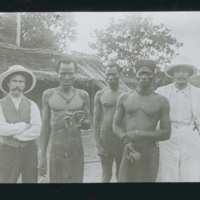
Men of the Nsongo District
Men of the Nsongo District (ABIR concession) with hands of two of their countrymen Lingomo and Bolenge murdered by rubber sentries of ABIR Anglo-Belgian India Rubber Company in May 1904. The two European men are Mr Stannard and Mr Harris of the Congo Balolo Mission at Baringa. This image (Neg. 119) formed part of the Harris Lantern Slide Collection. Under King Leopold II the Congo Free State used mass forced labour to extract rubber from the jungle for the European market. As consumer demand grew King Leopold II's private army - the Force Publique - used violent means to coerce the population into meeting quotas, including murder, mutilation, rape, village burning, starvation and hostage taking. Alice Seeley Harris and her husband Reverend John H. Harris were missionaries in the Congo Free State from the late 1890s. Alice produced a collection of images documenting the horrific abuses of the African rubber labourers. Her photographs are considered to be an important development in the history of humanitarian campaigning. The images were used in a number of publications. The Harrises also used the photographs to develop the Congo Atrocity Lantern Lecture which toured Britain and the the USA raising awareness of the issue of colonial abuses under King Leopold II's regime. Source: Antislavery International.
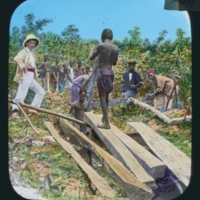
Free African Labour
Free African labour splitting timber. This image formed part of the Harris Lantern Slide Collection. Under King Leopold II the Congo Free State used mass forced labour to extract rubber from the jungle for the European market. As consumer demand grew King Leopold II's private army - the Force Publique - used violent means to coerce the population into meeting quotas, including murder, mutilation, rape, village burning, starvation and hostage taking. Alice Seeley Harris and her husband Reverend John H. Harris were missionaries in the Congo Free State from the late 1890s. Alice produced a collection of images documenting the horrific abuses of the African rubber labourers. Her photographs are considered to be an important development in the history of humanitarian campaigning. The images were used in a number of publications. The Harrises also used the photographs to develop the Congo Atrocity Lantern Lecture which toured Britain and the the USA raising awareness of the issue of colonial abuses under King Leopold II's regime. Source: Antislavery International.
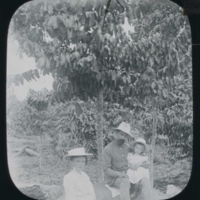
European Family
European family. This image formed part of the Harris Lantern Slide Collection. Under King Leopold II the Congo Free State used mass forced labour to extract rubber from the jungle for the European market. As consumer demand grew King Leopold II's private army - the Force Publique - used violent means to coerce the population into meeting quotas, including murder, mutilation, rape, village burning, starvation and hostage taking. Alice Seeley Harris and her husband Reverend John H. Harris were missionaries in the Congo Free State from the late 1890s. Alice produced a collection of images documenting the horrific abuses of the African rubber labourers. Her photographs are considered to be an important development in the history of humanitarian campaigning. The images were used in a number of publications. The Harrises also used the photographs to develop the Congo Atrocity Lantern Lecture which toured Britain and the the USA raising awareness of the issue of colonial abuses under King Leopold II's regime. Source: Antislavery International.
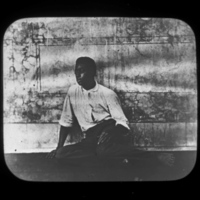
Enslaved African
An image of an enslaved African seated on the ground. This image (Neg. 27) formed part of the Harris Lantern Slide Collection. This photograph formed part of the Harris Lantern Slide Collection. Under King Leopold II the Congo Free State used mass forced labour to extract rubber from the jungle for the European market. As consumer demand grew King Leopold II's private army - the Force Publique - used violent means to coerce the population into meeting quotas, including murder, mutilation, rape, village burning, starvation and hostage taking. Alice Seeley Harris and her husband Reverend John H. Harris were missionaries in the Congo Free State from the late 1890s. Alice produced a collection of images documenting the horrific abuses of the African rubber labourers. Her photographs are considered to be an important development in the history of humanitarian campaigning. The images were used in a number of publications. The Harrises also used the photographs to develop the Congo Atrocity Lantern Lecture which toured Britain and the the USA raising awareness of the issue of colonial abuses under King Leopold II's regime. Source: Antislavery International and Panos Pictures.
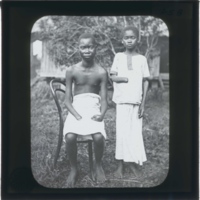
A Young Man and Child with Severed Limbs
A young man and child with severed arms. Mola (seated) had his hands destroyed by gangrene after being tied too tightly by soldiers. Yola (standing) was mutilated by soldiers who wanted to prove they had used the bullet to kill a rubber labourer. This photograph was taken by W. D. Armstrong. This image formed part of the Harris Lantern Slide Collection. Under King Leopold II the Congo Free State used mass forced labour to extract rubber from the jungle for the European market. As consumer demand grew King Leopold II's private army - the Force Publique - used violent means to coerce the population into meeting quotas, including murder, mutilation, rape, village burning, starvation and hostage taking. Alice Seeley Harris and her husband Reverend John H. Harris were missionaries in the Congo Free State from the late 1890s. Alice produced a collection of images documenting the horrific abuses of the African rubber labourers. Her photographs are considered to be an important development in the history of humanitarian campaigning. The images were used in a number of publications. The Harrises also used the photographs to develop the Congo Atrocity Lantern Lecture which toured Britain and the the USA raising awareness of the issue of colonial abuses under King Leopold II's regime.Source: Antislavery International and Panos Pictures. An account of Mola's experiences can be read in E. D. Morel, King Leopold's Rule in Africa (London: Heinneman, 1904), pp. 378-79.
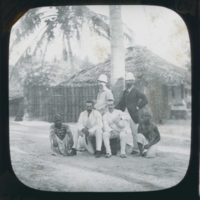
A Group of Consuls and Explorers
A group of consuls and explorers in East Africa. This photograph (Neg. 143) formed part of the Harris Lantern Slide Collection. Under King Leopold II the Congo Free State used mass forced labour to extract rubber from the jungle for the European market. As consumer demand grew King Leopold II's private army - the Force Publique - used violent means to coerce the population into meeting quotas, including murder, mutilation, rape, village burning, starvation and hostage taking. Alice Seeley Harris and her husband Reverend John H. Harris were missionaries in the Congo Free State from the late 1890s. Alice produced a collection of images documenting the horrific abuses of the African rubber labourers. Her photographs are considered to be an important development in the history of humanitarian campaigning. The images were used in a number of publications. The Harrises also used the photographs to develop the Congo Atrocity Lantern Lecture which toured Britain and the the USA raising awareness of the issue of colonial abuses under King Leopold II's regime. Source: Antislavery International and Panos Pictures.
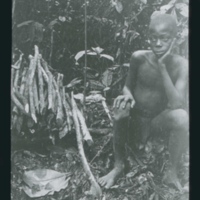
Young Boy Forced to Collect Rubber
A young boy forced to collect rubber for the Anglo-Belgium India Rubber Company (ABIR). The rubber quotas imposed on the indigenous population were so great that, as in this picture, the rubber vines were cut down rather than waiting for them to be tapped. As a result hardly any vines were left around the rubber stations. This image formed part of the Harris Lantern Slide Collection. Under King Leopold II the Congo Free State used mass forced labour to extract rubber from the jungle for the European market. As consumer demand grew King Leopold II's private army - the Force Publique - used violent means to coerce the population into meeting quotas, including murder, mutilation, rape, village burning, starvation and hostage taking. Alice Seeley Harris and her husband Reverend John H. Harris were missionaries in the Congo Free State from the late 1890s. Alice produced a collection of images documenting the horrific abuses of the African rubber labourers. Her photographs are considered to be an important development in the history of humanitarian campaigning. The images were used in a number of publications. The Harrises also used the photographs to develop the Congo Atrocity Lantern Lecture which toured Britain and the the USA raising awareness of the issue of colonial abuses under King Leopold II's regime. Source: Antislavery International and Panos Pictures.

Two African Men
Two African men - it appears that the standing man is having a metal shackle removed from his feet.This image formed part of the Harris Lantern Slide Collection. Under King Leopold II the Congo Free State used mass forced labour to extract rubber from the jungle for the European market. As consumer demand grew King Leopold II's private army - the Force Publique - used violent means to coerce the population into meeting quotas, including murder, mutilation, rape, village burning, starvation and hostage taking. Alice Seeley Harris and her husband Reverend John H. Harris were missionaries in the Congo Free State from the late 1890s. Alice produced a collection of images documenting the horrific abuses of the African rubber labourers. Her photographs are considered to be an important development in the history of humanitarian campaigning. The images were used in a number of publications. The Harrises also used the photographs to develop the Congo Atrocity Lantern Lecture which toured Britain and the the USA raising awareness of the issue of colonial abuses under King Leopold II's regime.Source: Antislavery International.

One Man and Four Women
One man and four women. This image formed part of the Harris Lantern Slide Collection. Under King Leopold II the Congo Free State used mass forced labour to extract rubber from the jungle for the European market. As consumer demand grew King Leopold II's private army - the Force Publique - used violent means to coerce the population into meeting quotas, including murder, mutilation, rape, village burning, starvation and hostage taking. Alice Seeley Harris and her husband Reverend John H. Harris were missionaries in the Congo Free State from the late 1890s. Alice produced a collection of images documenting the horrific abuses of the African rubber labourers. Her photographs are considered to be an important development in the history of humanitarian campaigning. The images were used in a number of publications. The Harrises also used the photographs to develop the Congo Atrocity Lantern Lecture which toured Britain and the the USA raising awareness of the issue of colonial abuses under King Leopold II's regime. Source: Antislavery International.
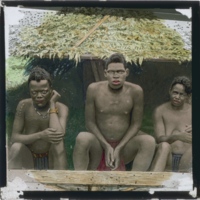
One Man and Two Women
One man and two women. This image formed part of the Harris Lantern Slide Collection. Under King Leopold II the Congo Free State used mass forced labour to extract rubber from the jungle for the European market. As consumer demand grew King Leopold II's private army - the Force Publique - used violent means to coerce the population into meeting quotas, including murder, mutilation, rape, village burning, starvation and hostage taking. Alice Seeley Harris and her husband Reverend John H. Harris were missionaries in the Congo Free State from the late 1890s. Alice produced a collection of images documenting the horrific abuses of the African rubber labourers. Her photographs are considered to be an important development in the history of humanitarian campaigning. The images were used in a number of publications. The Harrises also used the photographs to develop the Congo Atrocity Lantern Lecture which toured Britain and the the USA raising awareness of the issue of colonial abuses under King Leopold II's regime. Source: Antislavery International and Panos Pictures.
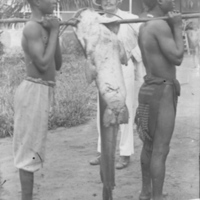
John Harris with Two African Men Holding a Large Fish
Reverend John Harris with two African men holding a large fish. This image formed part of the Harris Lantern Slide Collection. Under King Leopold II the Congo Free State used mass forced labour to extract rubber from the jungle for the European market. As consumer demand grew King Leopold II's private army - the Force Publique - used violent means to coerce the population into meeting quotas, including murder, mutilation, rape, village burning, starvation and hostage taking. Alice Seeley Harris and her husband Reverend John H. Harris were missionaries in the Congo Free State from the late 1890s. Alice produced a collection of images documenting the horrific abuses of the African rubber labourers. Her photographs are considered to be an important development in the history of humanitarian campaigning. The images were used in a number of publications. The Harrises also used the photographs to develop the Congo Atrocity Lantern Lecture which toured Britain and the the USA raising awareness of the issue of colonial abuses under King Leopold II's regime. Source: Antislavery International.
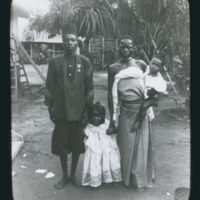
Congo State Soldier
Congo State Soldier (Force Publique), with his wife and child, and her mixed heritage Belgian infant. This image formed part of the Harris Lantern Slide Collection. Under King Leopold II the Congo Free State used mass forced labour to extract rubber from the jungle for the European market. As consumer demand grew King Leopold II's private army - the Force Publique - used violent means to coerce the population into meeting quotas, including murder, mutilation, rape, village burning, starvation and hostage taking. Alice Seeley Harris and her husband Reverend John H. Harris were missionaries in the Congo Free State from the late 1890s. Alice produced a collection of images documenting the horrific abuses of the African rubber labourers. Her photographs are considered to be an important development in the history of humanitarian campaigning. The images were used in a number of publications. The Harrises also used the photographs to develop the Congo Atrocity Lantern Lecture which toured Britain and the the USA raising awareness of the issue of colonial abuses under King Leopold II's regime. Source: Antislavery International.
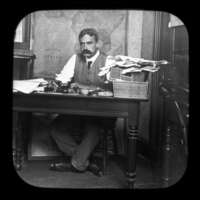
Edmund Dene Morel
A portrait of British abolitionist Edmund Dene Morel (1873-1924). Morel was a shippping clerk for the Liverpool company Elder Dempster which had a shipping contract between Antwerp and Boma. He raised the alarm about exploitative practices when he noticed that ships destined for the Congo Free State were packed with guns, chains and explosives rather than the usual trade good. In response to what he discovered Morel went on to found the Congo Reform Association. He also set up his own newspaper - The West African Mail - which focused on the commercial abuses being committed in the Congo Free State. This image (Neg. 7) formed part of the Harris Lantern Slide Collection. Under King Leopold II the Congo Free State used mass forced labour to extract rubber from the jungle for the European market. As consumer demand grew King Leopold II's private army - the Force Publique - used violent means to coerce the population into meeting quotas, including murder, mutilation, rape, village burning, starvation and hostage taking. Alice Seeley Harris and her husband Reverend John H. Harris were missionaries in the Congo Free State from the late 1890s. Alice produced a collection of images documenting the horrific abuses of the African rubber labourers. Her photographs are considered to be an important development in the history of humanitarian campaigning. The images were used in a number of publications. The Harrises also used the photographs to develop the Congo Atrocity Lantern Lecture which toured Britain and the the USA raising awareness of the issue of colonial abuses under King Leopold II's regime. Source: Antislavery International and Panos Pictures
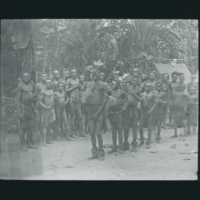
Procession of Native Dancers
'Procession of native dancers in honour of white men's visit to their village, Bolima Districts, upper Congo.' Description taken from the original caption for the archived photograph. MSS. Brit. Emp. S. 17 / B7 (Box 7), Bodleain Library, University of Oxford. This photograph formed part of the Harris Lantern Slide Collection. Under King Leopold II the Congo Free State used mass forced labour to extract rubber from the jungle for the European market. As consumer demand grew King Leopold II's private army - the Force Publique - used violent means to coerce the population into meeting quotas, including murder, mutilation, rape, village burning, starvation and hostage taking. Alice Seeley Harris and her husband Reverend John H. Harris were missionaries in the Congo Free State from the late 1890s. Alice produced a collection of images documenting the horrific abuses of the African rubber labourers. Her photographs are considered to be an important development in the history of humanitarian campaigning. The images were used in a number of publications. The Harrises also used the photographs to develop the Congo Atrocity Lantern Lecture which toured Britain and the the USA raising awareness of the issue of colonial abuses under King Leopold II's regime. Source: Antislavery International.
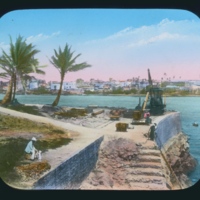
Port Scene
Port scene. This image formed part of the Harris Lantern Slide Collection. Under King Leopold II the Congo Free State used mass forced labour to extract rubber from the jungle for the European market. As consumer demand grew King Leopold II's private army - the Force Publique - used violent means to coerce the population into meeting quotas, including murder, mutilation, rape, village burning, starvation and hostage taking. Alice Seeley Harris and her husband Reverend John H. Harris were missionaries in the Congo Free State from the late 1890s. Alice produced a collection of images documenting the horrific abuses of the African rubber labourers. Her photographs are considered to be an important development in the history of humanitarian campaigning. The images were used in a number of publications. The Harrises also used the photographs to develop the Congo Atrocity Lantern Lecture which toured Britain and the the USA raising awareness of the issue of colonial abuses under King Leopold II's regime. Source: Antislavery International
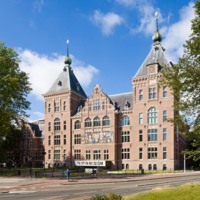
Tropenmuseum of World Cultures
The Tropenmuseum of World Cultures (direct translation; Museum of the Tropics) is an ethnographic museum, founded in 1864. Housed in one of the 'most impressive buildings in Amsterdam', the museum features eight permanent exhibitions and a series of temporary exhibitions. The key theme of the museum is people, with all of the exhibitions making use of the museum's vast collections of over 150,000 objects, paintings and photographs, to showcase universal human themes, including celebration, mourning and conflict.
In the 'Afterlives of Slavery' exhibition, visitors are confronted with the legacies of slavery and colonialism in contemporary Dutch society. Developed in collaboration with scientists, artists and activists, the exhibition tells the history of slavery with the experiences of the enslaved, and their descendants, at its heart. Video portraits provide the perspectives of four key figures in the contemporary debates about colonial legacies for Dutch black people.
The key link between past and present here is the continuation of inequality and prejudice. Collections, both historic and contemporary, highlight this, as well as illustrating how times have changed. These include testamonies of enslaved people, books, portraits, 'relics of slavery' and examples of African art.
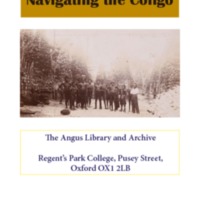
Navigating the Congo
Featuring artefacts, navigational equipment, maps, photographs, personal letters and diaries, Navigating the Congo is an exhibition which explored the history of non-conformist involvement in the Congo River regions during the 19th and 20th century.
By looking at the collections held in The Angus Library and Archive, the exhibition sought to bring to light some of the challenges faced in navigating this history and the relationships that developed between Baptist missionaries and the Kongo people during the period of European colonialism.
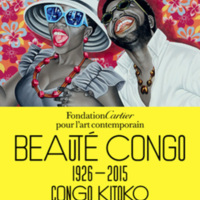
Beauté Congo – 1926-2015 – Congo Kitoko, Fondation Cartier, Paris (11 July 2015 - 10 January 2016)
A place of extraordinary cultural vitality, the creative spirit of the Democratic Republic of the Congo will be honored in the exhibition Beauté Congo – 1926-2015 – Congo Kitoko presented at the Fondation Cartier pour l’art contemporain with André Magnin, Chief Curator.
Modern painting in the Congo in the 1920s: Taking as its point of departure the birth of modern painting in the Congo in the 1920s, this ambitious exhibition will trace almost a century of the country’s artistic production. While specifically focusing on painting, it will also include music, sculpture, photography, and comics, providing the public with the unique opportunity to discover the diverse and vibrant art scene of the region.
Precursors: As early as the mid-1920s, when the Congo was still a Belgian colony, precursors such as Albert and Antoinette Lubaki and Djilatendo painted the first known Congolese works on paper, anticipating the development of modern and contemporary art. Figurative or geometric in style, their works represent village life, the natural world, dreams and legends with great poetry and imagination. Following World War II, the French painter Pierre Romain-Desfossés moved to the Congo and founded an art workshop called the Atelier du Hangar. In this workshop, active until the death of Desfossés in 1954, painters such as Bela Sara, Mwenze Kibwanga and Pili Pili Mulongoy learned to freely exercize their imaginations, creating colorful and enchanting works in their own highly inventive and distinctive styles.
Popular painters: Twenty years later, the exhibition Art Partout, presented in Kinshasa in 1978, revealed to the public the painters Chéri Samba, Chéri Chérin, and Moke and other artists, many of whom are still active today. Fascinated by their urban environment and collective memory, they would call themselves “popular painters.” They developed a new approach to figurative painting, inspired by daily, political or social events that were easily recognizable by their fellow citizens. Papa Mfumu’eto, known for his independent prolific comic book production and distribution throughout Kinshasa in the 1990s, also explored daily life and common struggles throughout his work. Today younger artists like J.-P. Mika and Monsengo Shula, tuned-in to current events on a global scale, carry on the approach of their elders.
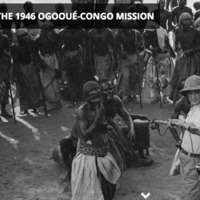
In the Footsteps of the 1946 Ogooué-Congo Mission, Online Exhibition, Europeana Collections
In 1947, 70 years ago, the public discovered one of the first sound recordings of Pygmy music collected in Equatorial Africa by the French ethnomusicologist Gilbert Rouget.
These were recorded during the Ogooué-Congo Mission, a scientific expedition led by the 23-year old French ethnologist Noël Ballif. This mission was the first organised by the Liotard group, a collective of young French explorers from Paris’ Musée de l’Homme.
From July to December 1946, the 12 members of the expedition travelled across the former Middle Congo (the current Republic of the Congo) and Gabon. They spent six weeks completely immersed in Bambinga Pygmy tribes from the Haute Sangha region, in the North of Moyen Congo - an experience that turned out to be decisive for some of them.
Whether they are sound recordings, photographs, films, artifacts or scientific studies, the documents collected and produced during and after the Ogooué-Congo Mission allow us to discover their adventure.
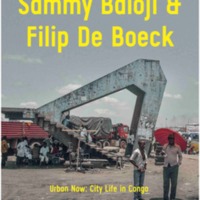
Urban Now: City Life in Congo, Various Venues (2016-2017)
This exhibition by photographer Sammy Baloji and anthropologist Filip De Boeck offers an exploration of different urban sites in Congo, through the media of photography and video. Focusing upon the “urban now”, a moment suspended between the broken dreams of a colonial past and the promises of neoliberal futures, the exhibition offers an artistic and ethnographic investigation of what living – and living together – might mean in Congo’s urban worlds.
As elsewhere on the African continent, Congo’s cities increasingly imagine new futures for themselves. Today, these new urban dreams often only manifest themselves in the form of billboards and advertisements for the city to come, inspired by Dubai and other recent hot spots from the Global South. Ironically, the city model they propose invariably gives rise to new geographies of exclusion that often take the form of gated communities and luxury satellite towns designed for a still somewhat hypothetical local upper middle class.
In sharp contrast with these neoliberal imaginings, the current infrastructure of Congo’s cities is of a rather different kind. The built colonial legacy has largely fallen into disrepair. Its functioning is punctuated by constant breakdown, and the city is replete with disconnected fragments, reminders and echoes of a former modernity that continues to exist in a shattered form. These failing material infrastructures greatly impact upon the quality of the city’s social life, and push it to the limit of what is livable. Yet Congo’s urban residents constantly engage in inventing new social spaces to bypass or overcome breakdown, exclusion, poverty and violence. Exploring these spaces, the exhibition captures a more inhabitable and inclusive urban world, where the possibilities of collective action and dreams of a shared future continue to be explored.
Curator: Devrim Bayar
The exhibition is organized in collaboration with and will travel to Galerias Municipais/EGEAC, Lisbon, and The Power Plant, Toronto.
With the support of the Research Fund of KU Leuven and Imane Farès Gallery, Paris.
In collaboration with Kunstenfestivaldesarts & Summer of Photography 2016.